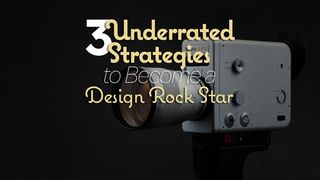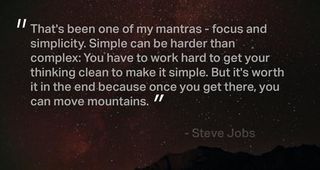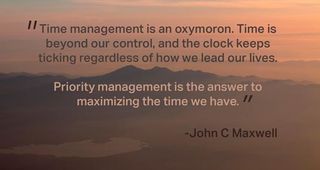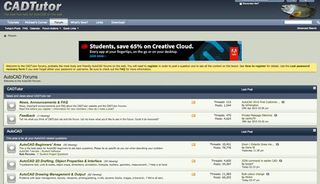3 underrated strategies to becoming a design rock star
Want recognition for your overlooked talents? Designer Will Gibbons shows the way.

I work in industrial design. But whatever your discipline, for those starting out, design can be daunting.
Fortunately, with a little strategy, we can clear the debris from the road to becoming an elite designer, making those skills much more attainable. Here are three ways to get there faster.
01. Focus
Focus means to act and think without distraction. A distraction is anything that consumes time, preventing you from putting in the houses needed to improve a skill. For example, if you're trying to focus on becoming a better CAD modeller, sketching or reading about design research or 3D rendering could be seen as a distraction.
It can be easy to think that since it's all relevant to design, it's beneficial. To some degree that's true, but to improve a technical skill, you simply need to put in the hours doing that one skill.
Focusing on one thing is the fastest way to get better at something. The more time you do it, the better you'll get at it. Also, with noticeable improvement comes motivation to keep going.

If you spread your time across 25 things, you'll only see minor (or possibly not any) improvement in each area. You'll be tired from trying to do so much and the lack of notable improvement leads to the feeling of defeat. This is why many people do not get very good at many things.
02. Sequential selection
We've got a long life to live, so stop trying to do so much at one time. As I've already mentioned, doing many different things at once isn't a fast way to learn. It's time to consider performing everything you want to learn sequentially.
Get the Creative Bloq Newsletter
Daily design news, reviews, how-tos and more, as picked by the editors.
Focus on one topic for a while to get good at it and when your progress begins to plateau, move on to the next item on your list.
This is almost always the fastest way to results and a great way to develop yourself into the rock star designer you know you can become. How do you decide what to do when? That's the third step...
03. Priority
Priority means one task is assigned more importance than others. When you prioritize, you come up with an analytical way to decide what's more important than everything else. A great way to do this is to work backwards from your goal.

This is often called deconstructing. Begin by writing down your goal. Let's say for example, that you wish to become the go-to designer for modeling complex, beautiful 3D forms. What would it take for you to become known as the CAD designer?
- The well-known expert might be one step away from becoming the master CAD designer. This means you rank high on a Google search for those keywords. It means you've got a website that many designers have seen before and even visit regularly to learn from. It means you've been published in many trusted magazines and electronic publications. It means you've published on the topic before as well and that your skills are top-notch.
- The expert-level user might be one step away from being the well-known expert. This means that you're not necessarily highly-published, but there are traces of proof online that support your skill level in CAD software. Samples of your work are recognized for being good and can be found on some niche websites or in your portfolio. It also means that people don't need to look far to find you.
- Finally, as an expert, you've likely taught CAD before, and you make the program bend to your will, allowing you to create anything you can imagine in CAD.

- The advanced user may be one step away from being an expert-level user. Advanced users can be found supporting others on the CAD forums. This means their portfolio shows promise of a strong focus and interest in CAD and a desire to improve.
- Advanced users spend much of their time learning about the latest capabilities and interesting ways to use the tools they're familiar with. Advanced users spend time being active in the CAD community and networking with CAD professionals who have a higher level of expertise.
- An intermediate user might be one step away from becoming an advanced user. This means that you're better than most, but still have quite a bit to learn. You're constantly learning new techniques and you can build some complex models, but you're not very fast or efficient yet. You're often surprised at how much more can be done within the program/s you use and you're often watching tutorials in an effort to get to the next level. You're sharing what you learn as well as following others on social media in order to try and reach the next level.
- A beginner may be one step away from becoming an intermediate. Beginners are able to find their way around the CAD package, but by no means are they familiar with most of the tools and methods used to create complex geometry. They're familiar with the industry and some lingo as well as large companies and industry leaders. They're easily fascinated and impressed with some expert-level CAD models and have no clue how the models were made. They're hunger to learn more about CAD and their passion makes them energetic like a puppy who's yet to become jaded by things like a tennis ball or vacuum cleaner.
- A newbie might be one step away from becoming a beginner. Newbies are pretty much clueless about what they're interested, other than having a deep appreciation for the field. A newbie CAD member may not know anything other than what the professionals do and are responsible. Newbies are like horses at the starting line at the Kentucky derby and can't wait to get going.
Deconstruction is the tool I use to identify my priority. Deconstruction helps you understand what you need to do to keep progressing. If your priority is always to get to the next level, look at what you wrote for each level and turn each attribute into actionable steps.
Make a sequential list of what you'll need to do to get closer to your goal every day. Being constantly reminded of your priority is a great way to make slow, steady progress, so if you need to, write or print out your priorities and goals somewhere you'll see them daily.
The three-pronged approach
Any one of the three methods described above will bring you closer to your goals, but the real power comes from using all three together. By prioritizing the list of disciplines you're expected to learn as a [roduct designer, then deconstructing your goal using the method demonstrated above and focusing on attaining that goal and getting closer each day, you'll be well-on your way to becoming the design guru you want to be.
Prioritizing is the what. What you will focus on in what order.
Deconstructing is the how. How you will become better at your craft.
Focus is the why. Why you do what you do. [To achieve greatness.]
Words: Will Gibbons
Will Gibbons is a product design consultant who blogs about how to find meaningful work and becoming employed wherever you wish at industrial design website pdn9.com. To get a free copy of The Industrial Designer's Guide to Freelancing, head on over and hop on the pdn9 mailing list.
Like this? Read these!
- The designer's guide to working from home
- Download the best free fonts
- Download free textures: high resolution and ready to use now

Thank you for reading 5 articles this month* Join now for unlimited access
Enjoy your first month for just £1 / $1 / €1
*Read 5 free articles per month without a subscription

Join now for unlimited access
Try first month for just £1 / $1 / €1
The Creative Bloq team is made up of a group of design fans, and has changed and evolved since Creative Bloq began back in 2012. The current website team consists of eight full-time members of staff: Editor Georgia Coggan, Deputy Editor Rosie Hilder, Ecommerce Editor Beren Neale, Senior News Editor Daniel Piper, Editor, Digital Art and 3D Ian Dean, Tech Reviews Editor Erlingur Einarsson, Ecommerce Writer Beth Nicholls and Staff Writer Natalie Fear, as well as a roster of freelancers from around the world. The ImagineFX magazine team also pitch in, ensuring that content from leading digital art publication ImagineFX is represented on Creative Bloq.
